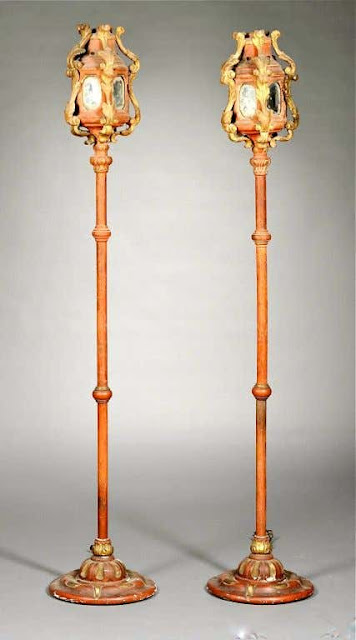Antique lanterns are always a great accent accessory for the old world home. There are many beautiful styles to look for as you peruse antique shops, auctions, second hand and thrift stores, etc. I especially like the pole lanterns so this post will feature the Venetian gondola lantern with another to follow soon all about the religious processional lanterns.
Venice, while charming by day, I am told is extraordinarily beautiful at night. One of Europe's most romantic cities now has approximately 500 gondolas traveling the 150 canals that meander through it. A nocturnal gondola ride must be breathtaking. However, during the 17th-18th centuries it is said that these these canals were crossed by over 10,000 gondolas. Can you even imagine the spectacular sight of the darkness alive with these flickering antique gondola lanterns.
These lovely gondola lanterns are sought after and treasured antiques that are presently popular for decorating the homes of collectors as well as those just wanting an old world flavor added to their homes. If you are fortunate enough to have one already....treasure it. If you find one for sale somewhere and can afford it.....buy it. The instant old world feel they bring to a space is worth it. Happy treasure hunting!!!
Lanterns called fanali were used to light the gondolas. I have tried and tried but really can't find info on if the gondola lanterns started out on poles or were eventually transferred to them.
Giovanni Antonio Canal
Gondolas were a bit different from the simpler black ones we see in Venice today. They could be quite elaborate as seen in these two paintings by Giovanni Antonio Canal. I can see elaborate poled lantern torches used on gondolas like these because there would be plenty of room for them.
Gondolas were a bit different from the simpler black ones we see in Venice today. They could be quite elaborate as seen in these two paintings by Giovanni Antonio Canal. I can see elaborate poled lantern torches used on gondolas like these because there would be plenty of room for them.
Giovanni Antonio Canal
I do know that among the Venetian nobility it became popular to compete with each other for the most beautiful and luxurious gondolas. Maybe they used plain lanterns on simple gondolas and the more ornate on expensive ones. Can't seem to find that out.
Palazzo Widmann
Like an expensive car, the gondola became a status symbol with elaborately carved and gilded ornamentation. For the interiors seasonal fabrics such as silk and velvet were used that added to the luxury. Maybe it became fashionable for the elite to put their lanterns on a pole....like a floor lamp or torch.
1stdibs.com
In fact gondola decorating in 1562 got so far out of hand that the authorities banned what was seen as sinfully ostentatious ornamentation and the Venetian Doge decreed that all gondolas were to be painted black. They are still black today.
A gilt metal 19th century gondola lantern attached to gilt and painted wood pole. Of course this one has been electrified. She is showing how they would hold the lanterns.
via Pinterest.fr
via Pinterest
Exceptional pair of large 18th century wood and glass Baroque Venetian gondola lantern torches.
A pair of late 19th century Venetian bronze and red painted gondola lanterns. This shows just how beautiful these lanterns are when electrified and used in your old world interiors.
via Olimpia Orsini
source unknown
You can see a beautiful gondola lantern in the background of this interior in Villa Fontana, the home of collector Bill Eberhardt.
Throughout medieval Europe religious sculptures in wood and other media were often brightly painted or colored, as were the interiors of church buildings. This is called polychrome. Many Venetian gondola lanterns were polychromed.
A lovely pair of red polychromed Venetian gondola lantern torcheres. Polychrome from the Greek .... "poly-", meaning "many" and "chromos", meaning "color."
A 19th century Gondola lantern from Venice, Italy. Polychromed and stamped tin, wood and glass, it is 6 sided and decorated with leaves, scrolls, and flowers. The top is a wood finial. You can see how the lantern is meant to be inserted onto a decorative pole.
A painted hexagonal tole gondola lantern with putto supports and embellished allover with gilt. This one has a spiral twist pole that has been painted blue.
via Pinterest
Whether you just lean them in a corner or electrify and use them on a regular basis these gondola lanterns just reek with old world charm.
Beautiful gondola lantern with cherub head embellishments.
Another clever way to enhance your decor with antique Venetian gondola lanterns.
via Pinterest
source unknown
And yet the gondola lantern's old world elegance is as much at home in a simple and shabby interior.
via Pinterest
I love a casual old world vignette involving one or more of these lovely gondola lanterns simply leaned against the wall.
etsy.com
I have Venetian gondola lantern envy over these beauties!!! I can think of so many places to put them.
Pamono.com
Most gondola lanterns were gilt or painted wood. However some were metal and here is where it gets tricky. Religious ceremonial lantern torches were also usually metal so it is easy to mix them up. This could be religious so don't be too harsh if I am incorrect.
More gondola lantern torches in the loggia of Bill Eberhardt's Villa Fontana.
It is hard enough to find single gondola lanterns, but in pairs......super fortunate!!
Click here to see the previous post
This blog post was published by Lisa Farmer
In the event that I have not credited the correct source of an image, please contact me at lisafarmerdesigns46@yahoo.com and I would be glad to correct it.










































































